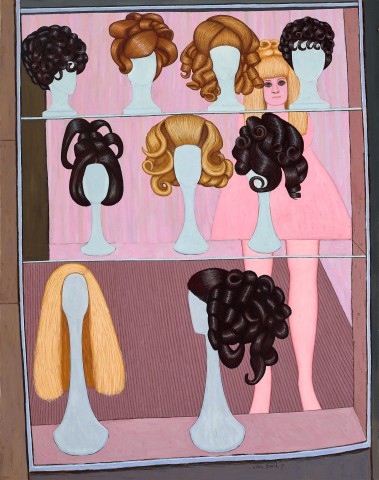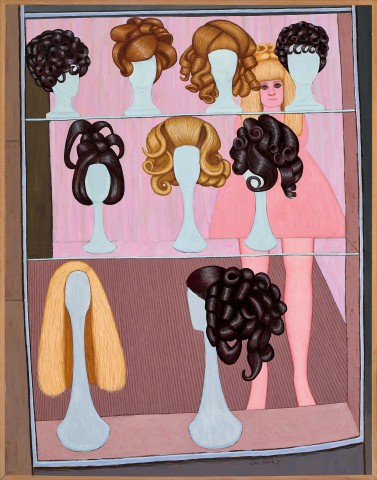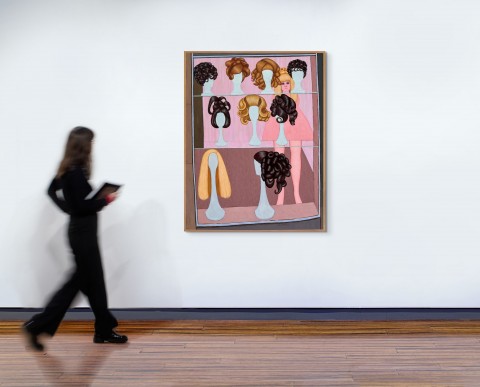WIG SHOP WINDOW, 1970
JOHN BRACK
oil on canvas
146.0 x 114.5 cm
signed and dated lower right: John Brack 70
signed and inscribed with title verso: JOHN BRACK / 'WIG SHOP WINDOW'
Leonard French, Heathcote, Victoria, acquired directly from the artist in the 1970s
Thence by descent
Private collection, Melbourne
John Brack: A Retrospective Exhibition, National Gallery of Victoria, Melbourne, 10 December 1987 – 31 January 1988, cat. 78 (label attached verso)
Lindsay, R., John Brack: A Retrospective Exhibition, National Gallery of Victoria, Melbourne, 1987, cat. 78, pp. 125, 140
Grishin, S., The Art of John Brack, Oxford University Press, Melbourne, 1990, vol. I, p. 124; vol. II, cat. o177, pp. 24, 138 (illus.)
Wig Shop with Pink Lampshade, 1970, oil on canvas, 130.0 x 89.0 cm, private collection, illus. in Lindsay, R., John Brack: A Retrospective Exhibition, National Gallery of Victoria, Melbourne, 1987, cat. 79, p. 65
230440 THE OLD TIME_cmyk.jpg
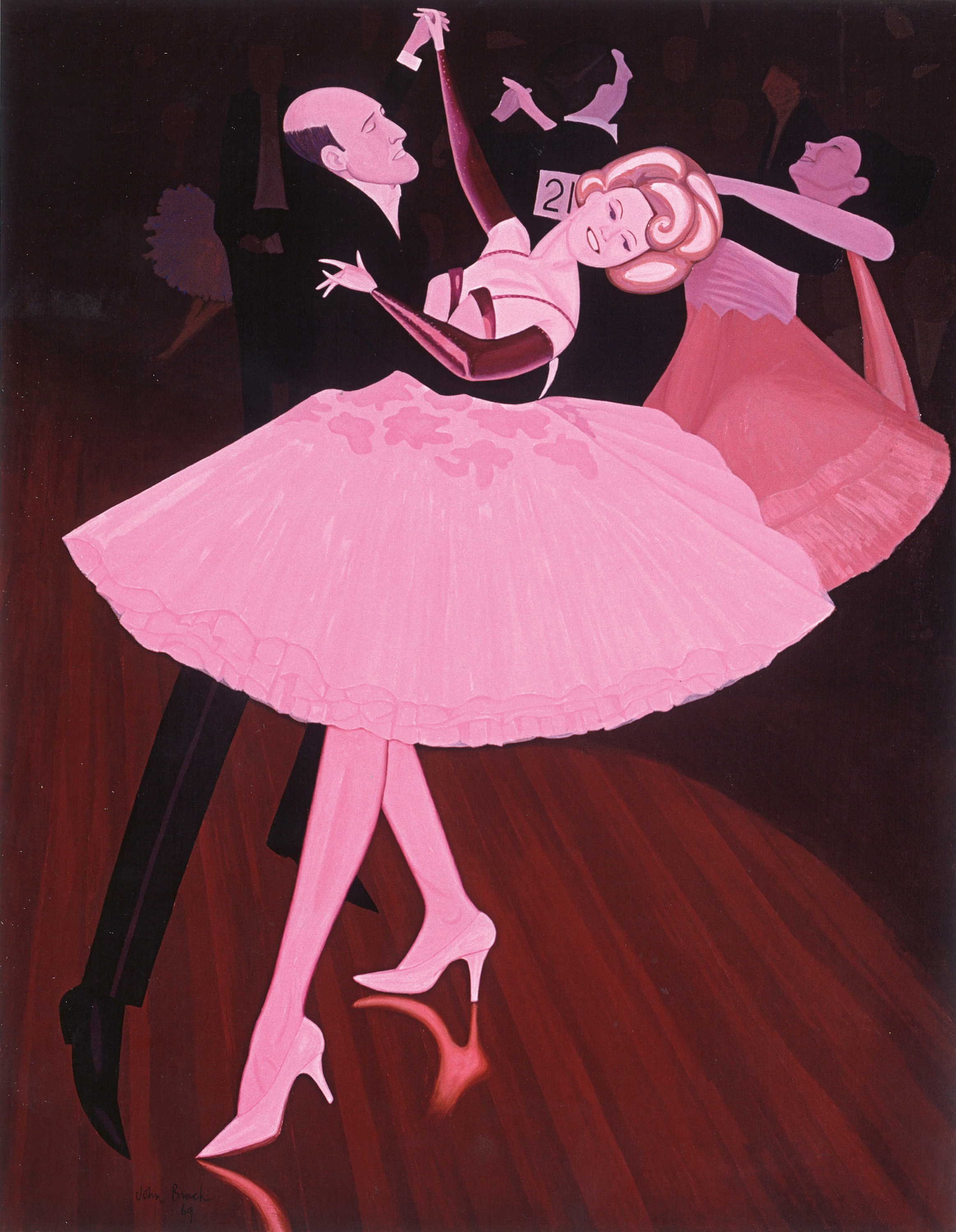
There has been much discussion in print and digital media about the so-called ‘pink tsunami’ associated with the marketing of Greta Gerwig’s Barbie movie. Our recent saturation in PANTONE 219C (Barbie Pink) in fact has a much longer and wider popular culture context, of which the present work is exemplary.
In the post-war years, prior to John Brack’s painting The Wig Shop Window, the association of the colour pink with perceptions of femininity steadily gathered momentum, from the fuschia Trevilla creation worn by Marilyn Monroe in the ‘Diamonds are a girl’s best friend’ sequence of Billy Wilder’s Some like it hot (1953) and Kay Thompson’s fashion anthem ‘Think pink’ in Stanley Donen’s Funny face (1957), to the hot pink Mary Quant A-line modelled by Twiggy in 1966; from the ‘First Lady Pink’ affected by Mamie Roosevelt to the iconic pink wool Chanel suit worn by Jacqueline Kennedy on the day of her husband’s assassination.
230440 RAY AND JUDY_cmyk.jpg
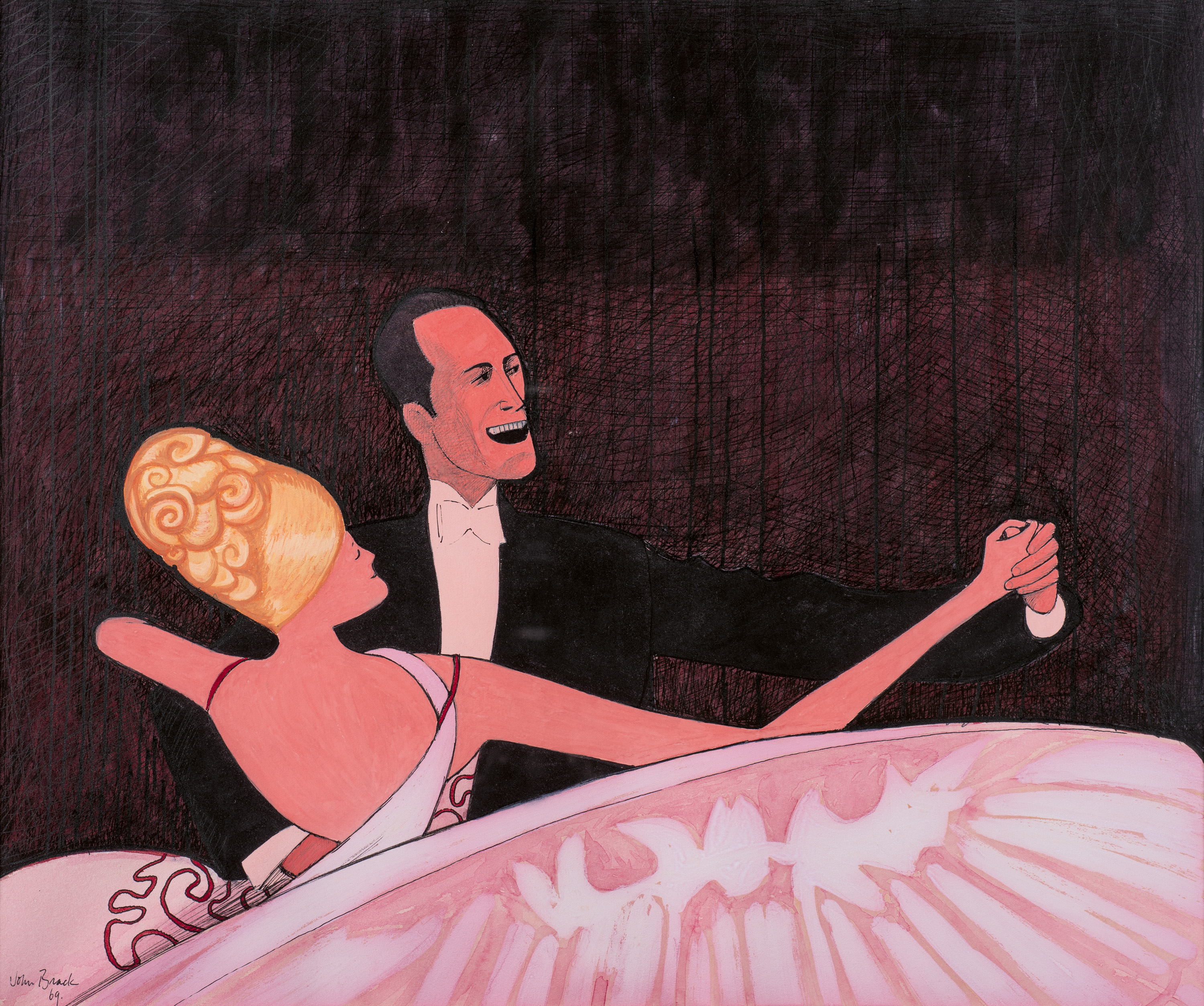
John Brack’s painting inherits these trends, while addressing the very specific historical context of 1970, when (according to the Women’s Weekly) ‘Summer pink [was] the in color for the current pretty-girl look and for the fashion mood of soft curves. Paris says lots of pink for day and night and it comes in a galaxy of shades – hot pink, soft pink, pink in prints, and the new-again pink worn with black.’1 Brack is notably attentive to this chromatic wave, not only in the present work and its companion Wig shop with pink lampshade, 1970 (private collection), but in other pink pictures from the same season, notably the ballroom dancing series picture The old time, 1969 (TarraWarra Museum of Art), the still life Peonies, 1970 (Wollongong Art Gallery), and one of the first of a new series, Nude with pink rug, 1970 (private collection). In these works, the subtle dental-plastic greyed pink which the artist had employed in Veterinary instruments, 1963 (private collection) and The scissors shop, 1963 (private collection) is lifted to an almost shocking lolly shade, as here: in the walls of the shop, and in the legs, skirt and face of the shop assistant, the garishness offset by roseate and purpled browns in the floor and window embrasures, and by the framing lavender-blue metal window frame.
Every bit as intriguing and compelling as its palette is the The Wig Shop Window's disegno, its composition. As with so many of Brack’s paintings, it combines deadpan social-satirical observation and flat finish with a subtle surrealism, a formal and spatial disorientation, an equivocation arising from disrupted vision. As Patrick McCaughey puts it: ‘behind the impersonal, unbroken surfaces lies a world which seethes with irony, ambiguity, where the normal is displaced or held in a difficult balance.’2
In his years working as head of the National Gallery School, then located in what is now State Library Victoria in Swanston Street, Brack did a lot of walking around the city, and the commercial displays of central Melbourne’s streets – medical suppliers, hardware stores and such – provided sympathetic stage sets for his theatre of waking dreams. He regularly employed the conceit of the shop window still life for almost a decade, from The scissors shop to Inside and outside, 1972 (National Gallery of Australia), ‘a succession of visionary flashes based on an unspoken contact between the sealed-off occupants (humans or apparently still life) of a glassed-in otherworld, and the intruder-observer-inspector who stares and waits and decides.’3
230440 Inside and Outside cmyk.jpg
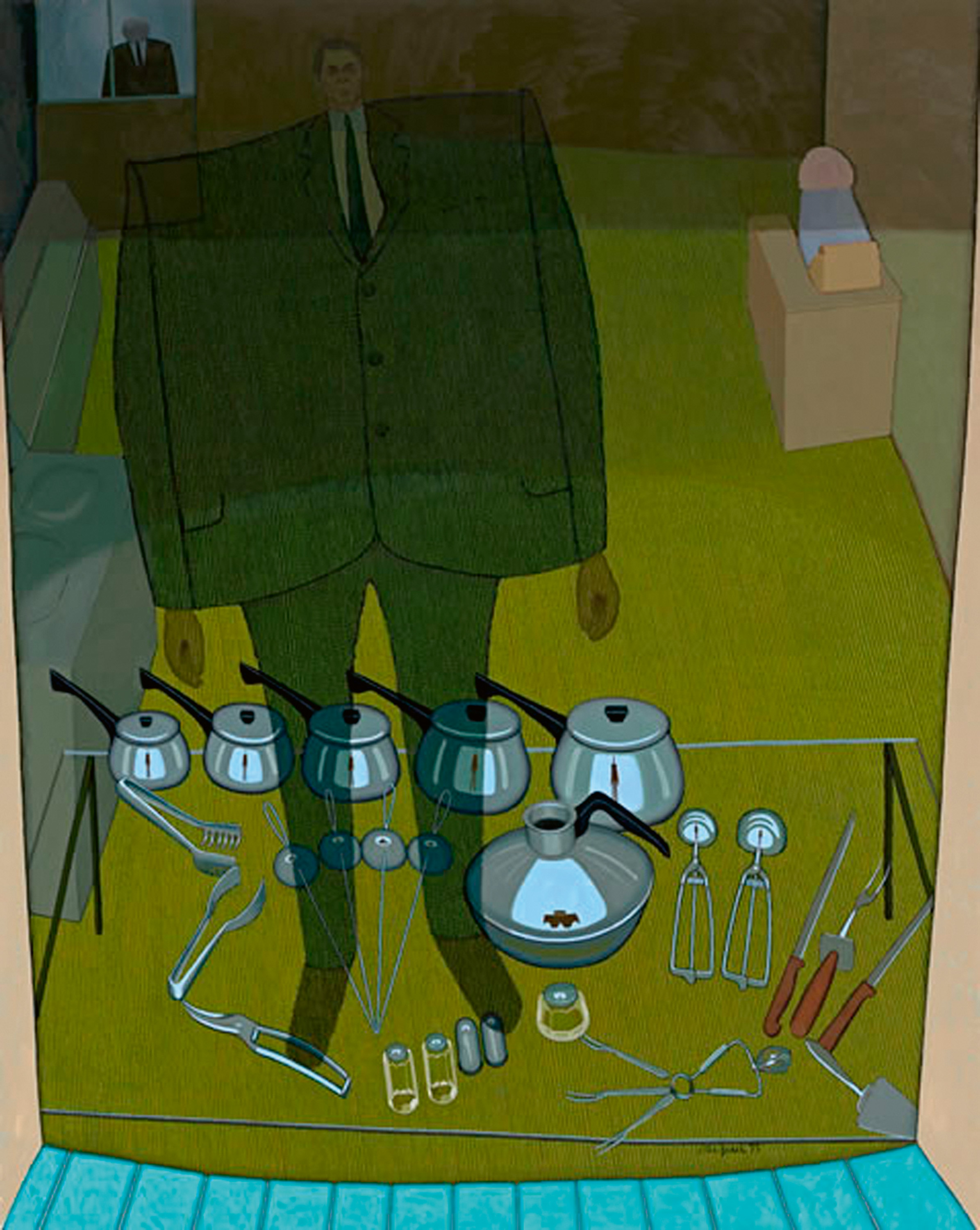
In the present work, Brack plays his perceptual and conceptual games through the window of Abe Lourie’s Swanston Street shop, ‘Creative Wigs.’ He creates an elusive, preconscious feeling of discomfort in the viewer through the exact alignment of the front of the middle shelf with the bottom edge of the back wall, through the alignment of the back of that same shelf with the bottom hem of the salesgirl’s mini-skirt, through the disappearance of the top of the doorway on the left into a mass of curls, and through the tilted, off-centre, not-quite-straight frame of the window. We feel, with Peter Tyndall, a certain ‘vertigo from… the absence of shadows and the playfully uncertain vanishing points.’4 Within this illusion box, this camera rosea, the consumer products are arrayed four-three-two along three glass shelves, the blank-faced light grey wig-stands looking like silver winner’s cups in a racing trophy case, or even South American Shuar tsantsa (shrunken heads) in a museum vitrine, each one of them surmounted by shiny, writhing Medusa curls in black, brunette and blonde.5
Brack Wig Shop Image 2.jpg
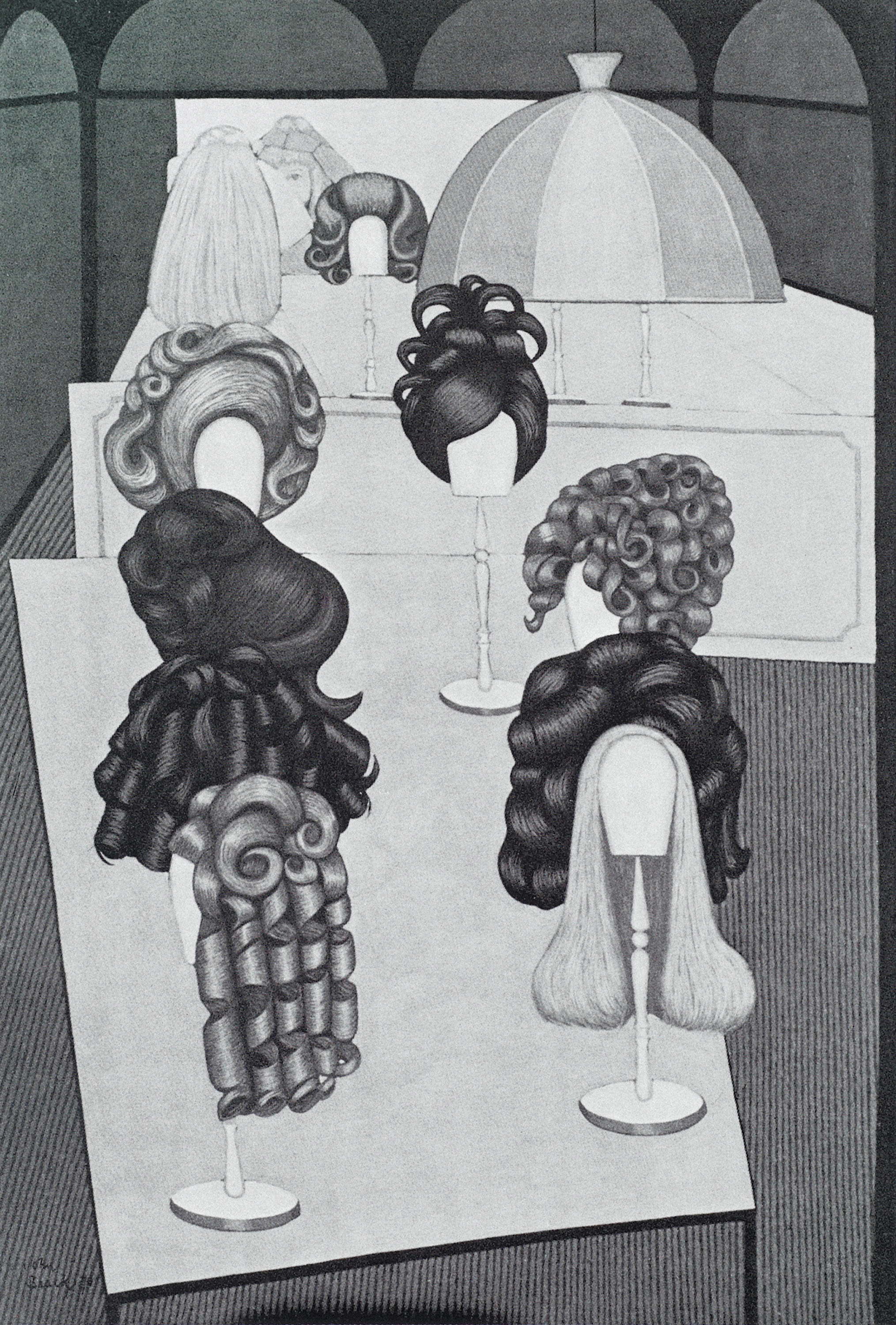
For all that Brack’s aesthetic depends on the flat-patterned, the angular-geometric, and the linear-spiky, he also displays a perverse fondness for the organic and curvilinear, and particularly for the representation of human hair. The big wigs of the present work have a full barber’s shop window full of curly-top precedents: from the carefully-painted, pony-tailed, and beribboned Little girl’s head (Vicky), 1955 (private collection) and the tousled top of a short-back-and-sides in Portrait of Fred Williams, 1958 (Art Gallery of South Australia) to the Mister Whippy soft-serve ice cream cloud of hair above a spanner mouth in The queen’s aria, 1960 (private collection) and the cake icing/pavlova impastoed veils and hats of the wedding series of 1960 – 61, even the blue floral hat worn by Barry Humphries in the character of Mrs Everage, 1969 (Art Gallery of New South Wales). Here, bolstered by contemporary tonsorial fashion, he goes to town with half a dozen fantastic inventions of Baroque complexity and Rococo caprice – coils, folds, hooks, S-curves – looking for all the world like microscopic or marine invertebrate flora or fauna.
Perhaps more disturbing either than Brack’s fictive architecture or the alien life form hairpieces is his placement of the figure, presented in such a way that she seems to have neither shoes nor arms, with her head appearing to sit on the top shelf, squeezed in between and slightly below the brown and black trichological competition. On her proper left side, the neck curve of the wig-stand in front trims her generous coiffure into a bob. The celebrated flatness, the forwardness of Brack’s painted surface places her on the same plane as the shop’s inventory, while the blank, bored, inscrutable expression on her face, with its heavily mascaraed eyes and straight-line Revlon Sky Pink lips, is oddly inhuman, more that of a mannequin than of a flesh and blood woman. No Women’s Weekly ‘soft curves’ here. Rather, she is of a piece with the model figures in the earlier shop window series, ‘replicas of human life, figures not quite materialized into human bodies.’6
Reviewing Brack’s series of nudes with Persian carpets that immediately followed this work, Daniel Thomas observed: ‘Obviously he likes toying with real versus artificial. He has been very interested in false legs, false hair, tailor’s dummies, forced expressions, reflections… All this is a reminder that any picture is itself artificial, too.’7 A masterly exercise in airless artifice, The Wig Shop Window is John Brack at the height of his powers: of observation, of construction, and of wit.
1. Keep, B., ‘Summer pink pretty-girl’, Australian women’s weekly, 14 January 1970, p. 20
2. McCaughey, P., ‘The complexity of John Brack’, in Robert Lindsay (ed.), John Brack: a retrospective exhibition, National Gallery of Victoria, Melbourne, 1987, p. 8
3. Millar, R., John Brack, Lansdowne Press, Melbourne, 1971, p. 18
4. Tyndall, P., ‘John Brack retrospective at Ian Potter Centre: National Gallery of Victoria’, bLOGOS/HA HA, 24 April 2009 https://blogos-haha.blogspot.com/2009/04/john-brack-retrospective-at-ian...
5. The work was formerly owned by Brack’s contemporary and friend, the painter Len French. He maintained that Brack painted the plain, straight wig at the bottom left as a sly portrait à clef of Brack’s wife Helen.
6. McCaughey, op. cit.
7. Thomas, D., ‘Display of nudes’, Sunday Telegraph, 11 April 1971
PROFESSOR DAVID HANSEN
